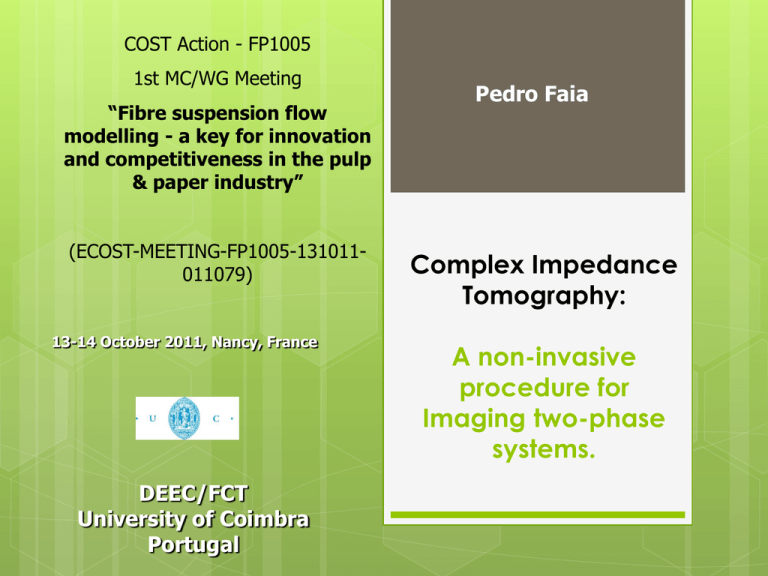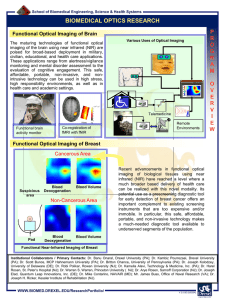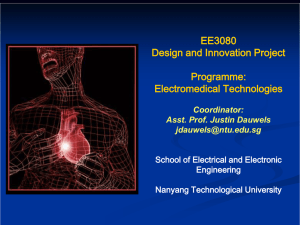A non-invasive procedure for imaging two
advertisement

COST Action - FP1005 1st MC/WG Meeting “Fibre suspension flow modelling - a key for innovation and competitiveness in the pulp & paper industry” (ECOST-MEETING-FP1005-131011011079) 13-14 October 2011, Nancy, France DEEC/FCT University of Coimbra Portugal Pedro Faia Complex Impedance Tomography: A non-invasive procedure for Imaging two-phase systems. Complex Impedance Tomography: A non-invasive procedure for Imaging two-phase systems. Presentation Outline o Brief Introduction. o Tomographic system. o Mathematical formulation. o Solid-liquid suspensions results. o Fiber-flow Tomography approach. Complex Impedance Tomography: A non-invasive procedure for Imaging two-phase systems. Electrical Tomography overview In the development of accurate models for suspension related processes, prior knowledge of several flow characteristics is essential, such as spatial distribution of phases, flow regimen, interfacial area, and relative velocity between phases, amongst others. Complex Impedance Tomography: A non-invasive procedure for Imaging two-phase systems. Advantages over other methods Tomography offers a unique opportunity to reveal the complexities of the internal structure of an object without the need to invade it. Electrical Tomography offers a vast field of possibilities due to its low cost, portability and, above all, safety of handling, since there is no need to use radiations which require special usage care and lead to dangerous wastes. Complex Impedance Tomography: A non-invasive procedure for Imaging two-phase systems. Overall view of the actual tomographic system Complex Impedance Tomography: A non-invasive procedure for Imaging two-phase systems. Main modules Signals Generation/Amplification and Control Voltage generator instead of source generator - proved to surpass the limitations of a traditional current source when applied to more conductive media. Multiplexing/Demultiplexing Signal delivery to electrodes – allow multiple injection and aquisition protocols (user defined). Demodulation analog synchronous demodulation – based on multipliers, simple to conceive and fast operation. DAQ boards National Instruments USB – insure portability of the system and connection to any PC. Complex Impedance Tomography: A non-invasive procedure for Imaging two-phase systems. Coimbra tomographic system Vs. available in literature tomographic systems To circumvent difficulties and costs of designing a current source that suited the goals of the EIT system that was being designed, a choice was made to depart from traditional EIT systems, and instead a voltage source was projected. The EIT system designed has an image acquisition frame rate that can go up to 4000 frames per second and 1000 frames per second for the 16 and 32 electrodes rings, respectively, which are higher when compared with other EIT systems used in medical applications (Goharian et al.; Granot et al.), and even when comparing with recent DSP based electrical tomographic systems (Wilkinson et al.; Wang et al.; Shuai et al.). - Goharian M., Soleimani M., Jegatheesan A., Chin K. and Moran G., 2008. A DSP Based Multi-Frequency 3D Electrical Impedance Tomography System, Annals of Biomedical Engineering 36(9): 1594–1603. - Granot Y., Ivorra A., and Rubinsky B., 2007. Frequency-Division Multiplexing for Electrical Impedance Tomography in Biomedical Applications, International Journal of Biomedical Imaging 2007(2). - Wilkinson A.J., Randall E. W., Long T. M. and Collins A., 2006. The design of an ERT system for 3D data acquisition and a quantitative evaluation of its performance, Measurement Science and Technology 17(8): 2088–2096. - Wang M., Ma Y., Holliday N., Dai Y., Williams R. A. and Lucas G., 2005. A High-Performance EIT System, IEEE Sensors Journal 5(2): 289-299. - Shuai Z., Guizhi X., Huanli W., Duyan G. and Weili Y., 2006. Multi-frequency EIT Hardware System Based on DSP, Proceedings of the 28thIEEEEngineering in Medicine and Biology Society Annual International Conference, New York City, USA, Aug 30-Sept 3, 2006, pp. 6677 – 6680. Complex Impedance Tomography: A non-invasive procedure for Imaging two-phase systems. Coimbra tomographic system Vs. available in literature tomographic systems The tested flowing system consisted of a diluted NaCl solution and glass beads while most research groups concentrated their efforts in the characterization of liquid-gas/liquid-liquid flows, where the difference between phase conductivity is much higher than in our diluted one, making it easier to characterize and to map. Nevertheless out EIT system allowed us to get images of higher resolution: in fact, some EIT (Wang et al.) and ERT (Schlaberg et al.; Razzak et al.) imaging of solid-liquid flows found in the literature present lower resolution than the images captured with our system. Images of higher resolution were obtained only with ECT (Yang) for gas-solid flows (Dyakowski et al.) where a more contrasting conductivity characterizes the phases involved. - Schlaberg H.I., Baas J.H., Wang M., Best J.L., Williams R.A. and Peakall J., 2006. Electrical Resistance Tomography for Suspended Sediment Measurements in Open Channel Flows Using a Novel Sensor Design, Particle & Particle Systems Characterization 23 (3-4): 313–320. - Razzak S.A., Barghi S., Zhu J.-X., 2009. Application of electrical resistance tomography on liquid-solid two-phase flow characterization in an LSCFB riser, Chemical Engineering Science 64(12): 2851-2858. - Yang W., 2007. Tomographic Imaging based on Capacitance Measurement and Industrial Applications, IEEE International Workshop on Imaging on Systems and Techniques, 2007:1 - 6. - Dyakowski, T., Johansen, G. A., Hjertaker, B. T., Sankowski, D., Mosorov, V. and Wlodarczyk, J. (2006), A Dual Modality Tomography System for Imaging Gas/Solids Flows, Particle & Particle Systems Characterization 23: 260–265. Complex Impedance Tomography: A non-invasive procedure for Imaging two-phase systems. Mathematical Formulation Complete Electrode Model (CEM) Regularized Gauss-Newton algorithm Complex Impedance Tomography: A non-invasive procedure for Imaging two-phase systems. PILOT RIG overview Real Image Mesh 1 Mesh 2 Complex Impedance Tomography: A non-invasive procedure for Imaging two-phase systems. Static testing 2 kHz frequency and 1,5 V of amplitude. With this setup a 90 A current amplitude was applied to the domain. Mesh 1 is structured and has 1024 linear elements and 545 nodes. Mesh 2 is non structured, and has 415 linear elements and 241 nodes. For the image reconstruction the open source software EIDORS was used. The colour mapping in represents gradients of conductivity where red stands for higher conductivity gradients and blue for lower conductivity gradients. Vn i Vi Vri Vri Normalized difference voltages Complex Impedance Tomography: A non-invasive procedure for Imaging two-phase systems. Constant flow testing Flow rates: 0, 13, 33 and 52 m3/h. Solid liquid suspensions of spherical glass beads in diluted aqueous solution of NaCl (conductivity of 663 S/cm) flowing in the system. The bead sizes ranged from 400 to 600 mm in diameter. Around 2% volume concentration of spheres. Complex Impedance Tomography: A non-invasive procedure for Imaging two-phase systems. Undergoing work for fiber suspensions flow characterization New injection protocol – opposite instead of adjacent New excitation current frequencies – increase sensitivity to the conductivity of the different phases. New rings with titanium electrodes – avoid chemical and friction undesirable effects observed with the stainless steel electrodes. Electrodes of smaller area and increased spacing between them – increased electrode spacing along the tube perimeter allows sensitivity and resolution increase (the tests with low electrode spacing and large area electrode showed lack of sensitivity when concentration raised from and above around 3-4% for the solid liquid-suspensions tested). Complex Impedance Tomography: A non-invasive procedure for Imaging two-phase systems. Undergoing work for fiber suspensions flow characterization Electrodes electrical connection reformulation – instead of bnc connections which involve additional electrical interfaces all contributing to the overall system impedance, the new electrodes will have a single contact impedance interface. Second tomographic section suspensions velocity models. allow the exploitation of New inverse problem solving algorithms – the adoption of a nonlinear iterative method, such as modified Newton Raphson (MNR), offers more flexibility in the injection and measurement protocol choice. Images post-processing – methods such as Maximum Entropy Regularisation may allow the refinement of the previously obtained images, by helping clarifying the conductivity edges between the different phases (in this specific case, the plug ones). Complex Impedance Tomography: A non-invasive procedure for Imaging two-phase systems. New test ring sections and electrodes design Complex Impedance Tomography: A non-invasive procedure for Imaging two-phase systems. Thank you for you attention






